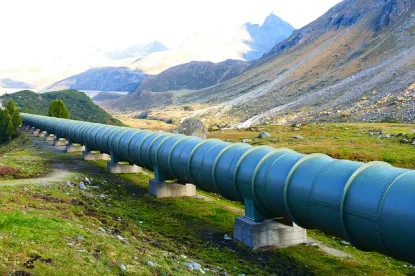On December 9, 2016, lawyers for Dakota Access, LLC (Dakota Access), the U.S. Army Corps of Engineers (Corps), the Standing Rock Sioux Tribe (Tribe), and the Cheyenne River Sioux Tribe appeared before the U.S. District Court for the District of Columbia (District Court) to address Dakota Access’s Motion for Summary Judgment (Motion) and Expedited Motion to Supplement the Administrative Record. In the Motion, Dakota Access claims that the Corps attempted to block construction of the Dakota Access Pipeline Project (DAPL) underneath Lake Oahe, in North Dakota, by purporting to withhold authorization that the Corps had, in fact, already granted. Dakota Access argues that the Corps completed all of the necessary determinations when it approved the crossing on July 25, 2016, under Section 408 of the Rivers and Harbors Act (Section 408 Permission). According to Dakota Access, the Section 408 Permission was tantamount to a right-of-way grant, or easement, under the Mineral Leasing Act (MLA). The Corps, on the other hand, asserts that an easement is a requisite and separate permission required by the MLA and subject to additional review under National Environmental Policy Act (NEPA).
Dakota Access initially raised the issue on November 15, 2016, as a cross-claim in the Tribes’ ongoing litigation against the Corps. On December 4, 2016, the Corps made an unexpected announcement that it would defer a decision on the Lake Oahe easement pending additional review and preparation of an Environmental Impact Statement (EIS). The day after, on December 5, 2016, Dakota Access filed a Motion for Summary Judgment of its cross-claim. Through the Motion for Summary Judgment, Dakota Access hopes to expedite the District Court’s consideration of its November 15 cross-claim, which potentially would invalidate the Corp’s proposed EIS process.
District Court Sets Briefing Schedule to Address Dakota Access’s Claim
In addition to the Motion, the December 9 hearing considered Dakota Access’s Expedited Motion to Supplement the Administrative Record (Expedited Motion). The Expedited Motion sought Corps documents related to the Corp’s activities occurring during the pendency of the litigation. In particular, the Expedited Motion sought documents related to the September 9, 2016 and October 10, 2016 joint statements issued by the Department of the Army (Army), Department of the Interior (DOI) and Department of Justice (DOJ) halting construction for additional review. Additionally, it sought documents with respect to a November 14 letter issued by the Army stating that additional discussion and analysis were warranted prior to issuing a final decision to grant an easement.
U.S. District Court Judge James E. Boasberg set a briefing schedule at the December 9 hearing to address Dakota Access’s Motion, which will run through the end of January. Pursuant to that schedule, the Army’s, the Tribe’s and the Cheyenne River Sioux’s (Tribes) opposition to to Dakota Access’s Motion are due by January 6, 2017. Dakota Access must file a Reply by January 31, 2017. Additionally, Judge Boasberg ordered the Army to supplement the record with all documents concerning the easement that were created on or before July 25, 2016 and make a good-faith effort to begin compiling related documents created after that date. Judge Boasberg also denied the Expedited Motion without prejudice pending the need to refile and seek additional documents in response to the Army’s brief. At the hearing, Dakota Access also clarified that it was not challenging the December 4, 2016 announcement as a final agency action at this time, but was seeking summary judgment based on the Section 408 Permission.
Background on Dakota Access
DAPL is a 1,172 crude oil pipeline that is planned to cross Lake Oahe, a dammed section of the Missouri River located one-half mile upstream of the Tribe’s reservation in North Dakota. The lake serves as a water source for the Tribe’s reservation and was built upon the Tribe’s ancestral lands. On July 27, 2016, the Tribe initiated litigation against the Corps, challenging the Corps’ July 25, 2016 determinations authorizing Dakota Access to construct DAPL underneath Lake Oahe in accordance with the Section 408 Permission and Section 404 of the Clean Water Act pursuant to a Nationwide Permit 12 (NWP 12). The Tribe’s complaint claimed that the Corps failed to appropriately consult with the Tribe pursuant Section 106 of the National Historic Preservation Act (Section 106), a consultation obligation triggered by the Section 408 Permission. The Tribe also sought to stop Dakota Access’s construction of the pipeline in the areas surrounding the Lake Oahe crossing through a Motion for Preliminary Injunction. That Motion was denied by the District Court (on September 9, 2016) and on appeal by the U.S. Court of Appeals for the District of Columbia Circuit (D.C. Circuit) (on October 10, 2016).
In response to the District Court and D.C. Circuit denials, the Army and the Corps halted construction at the crossing and asserted that a separate MLA easement requiring additional review is required. This Corps’ position of requiring additional review culminated in a December 4 Announcement that, prior to making a determination on the easement, the Corps would require the preparation of an EIS for the proposed crossing. A memorandum issued in conjunction with the Announcement by Jo-Ellen Darcy, the Assistant Secretary of the Army, Civil Works (Memorandum) provided further background on the decision to delay the determination, stating that the Army could not grant an easement to cross Lake Oahe on the current record and that a “robust consideration of reasonable alternatives . . . together with analysis of potential spill risk and impacts, and treaty rights” will be best accomplished through the preparation of an EIS. However, the Memorandum also explained that the decision to conduct an EIS did not alter the Corps’ prior reviews and actions – including an environmental assessment (EA) that contained a Mitigated Finding of No Significant Impact (FONSI), which was completed in support of the Section 408 Permission – which the memorandum confirmed “have comported with legal requirements.” Instead, the Corps cited the preparation of an EIS as a policy decision based on the “totality of circumstances in this case,” including the mandates of the MLA, the Tribe’s historical dispossession of lands, and Tribal treaty rights.
For additional background on the litigation and surrounding issues, please see prior Alerts published on September 13, 2016 and September 29, 2016.
What’s Next for DAPL?
Although the briefing schedule pushes out any judicial decision on Dakota Access’s underlying legal claim until at least the end of February, 2017, Judge Boasberg noted during the December 9 hearing that the impending change of Administration could moot the claims before him. Judge Boasberg acknowledged that the future of DAPL could hinge not on his decisions, but on actions taken by the next Administration once it takes office on January 20, 2017. And, he ordered the government attorneys to promptly notify the court should it change its position regarding the easement.
The President-elect has made public statements in support of DAPL. Given this support, it is possible that were the District Court ultimately to grant Dakota Access’s motion for summary judgment, the Corps, under a new directive, could choose not to challenge that decision on appeal. Alternatively, there is a chance the Army could reverse course and direct the Corps to grant the easement based on the existing EA and FONSI, or accept Dakota Access’s position that an easement was already granted. The Corps also could move forward with the EIS process initiated following the December 4, 2016 announcement and permit the Lake Oahe crossing following a finding that the existing proposed route is appropriate after consideration of alternatives. Any of these potential Army or Corps decisions would be considered final agency action subject to judicial review, and could result in additional court challenges. It is unlikely, however, given the change in Administration that the Corps would decide not to permit construction, even if that decision resulted in additional litigation.
Regardless of any future outcome, under the present circumstances, there can be no construction underneath Lake Oahe until either the Corps completes the EIS process and makes a determination based on that process, or the District Court determines that the permission already has been granted. Whether or when Dakota Access can complete the DAPL Lake Oahe crossing are far from resolved questions.
What Is the Future of Tribal Consultations in Federal Permitting Decisions?
Dakota Access’s and the Tribe’s experiences with the Corps has raised additional, far broader questions concerning the role of tribal input on federally-permitted infrastructure decisions. As explained in our prior Alert [link to 9/29 alert], government-to-government consultations were recently held with all 567 federally-recognized tribes, and resulted in 26 hours of comment from tribal leaders at in-person sessions, supplemented by more than 80 sets of written comments on the adequacy of existing Section 106 consultation protocols. It likely is too late for the current Administration to issue any regulations or propose any new legislation that accommodates and considers these comments. Any new Federal procedures on tribal consultations that could be issued in the next few weeks would be subject to reversal under the next Administration.
Regardless of what the Federal government does before or after January 20, 2017, tribes have learned from and have been empowered by their experiences protesting DAPL. Accordingly, it is expected that tribes likely will take a more active role in protecting their sacred sites, water, or other matters of concern to their communities. For this reason, Van Ness Feldman recommends that companies planning projects with components on or near Indian reservations update their procedures for consultation with the affected tribal governments to include early and continuing tribal communications. Van Ness Feldman offers a seminar, “Doing Business With Tribes,” that can assist companies lay the foundation for revising their procedures and is developing a best practices guide to assist clients with navigating the tribal consultation process.





 />i
/>i
